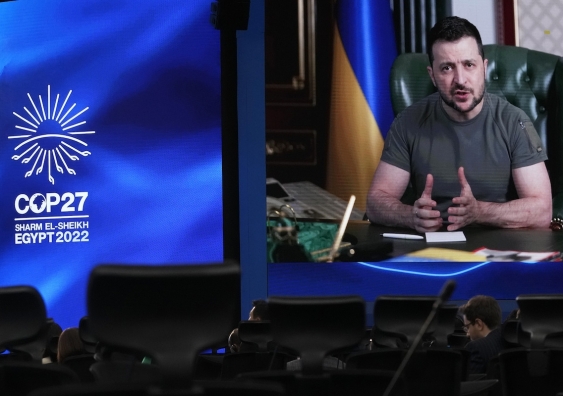Tensions and war undermine climate cooperation – but there's a silver lining
This year’s climate talks have been overshadowed by rising international tensions, energy crises and war. But that doesn’t mean climate action is dead.
This year’s climate talks have been overshadowed by rising international tensions, energy crises and war. But that doesn’t mean climate action is dead.

In retrospect, last year’s climate talks in Glasgow look like a dream. International cooperation on methane emissions and deforestation. Acknowledgement of the urgency of the task. The world beginning to rise to the challenge, as it did to the pandemic.
A lot has changed in a year. This week’s COP27 climate conference in Egypt comes amid war and disaster. Russia’s invasion of Ukraine saw fossil fuel prices spike and old coal plants temporarily reopen, while renewed tensions between the United States and China have cast a shadow over climate cooperation between the world’s top two carbon emitters.
You might think nations could put their tensions aside when it comes to climate change, which puts all of us – and our children – at risk. But so far, the signs are not great. At Glasgow, all 193 nations involved agreed to increase the ambition of their climate pledges. But on the eve of COP27, two dozen had actually done so.
While territorial tensions risk taking our focus away from the existential threat of climate change, there are positive signs such as a new rush to green energy on security grounds.
Politics and war tend to be separated in media coverage from climate change and environmental disasters. But they’re closely connected.
Military conflict – actual or threatened – strains diplomatic relationships. This makes collective action on any issue more difficult – even an existential threat like climate change. In August, the G20 climate talks in Bali a joint statement, largely due to Russia’s controversial presence amid its ongoing invasion of Ukraine. That same month, bilateral climate talks with Washington after US House Speaker Nancy Pelosi visited Taiwan, which Beijing sees as a breakaway province.
Geopolitical tensions also draw our leaders’ attention away from climate change. Leaders instead focus on immediate issues such as inflation, economic instability or energy security. Russia’s invasion sparked a global energy crisis and caused grave energy security concerns in many countries, .
From the outside, it might look bleak. Many European countries appear to have watered down their climate ambitions to tackle the immediate energy crisis over the northern winter. In June, some moved to to shore up energy security and avoid Russian gas. In July, the European Parliament to reclassify natural gas and nuclear energy as green investments, which could trigger a private investment wave. European countries have moved to of oil and gas from African and Middle Eastern suppliers, and new liquefied natural gas (LNG) terminals.
The energy crisis is less intense in the US, which has domestic supplies of gas and oil from fracking. Even so, the crisis could by some Republicans to push for “enhanced energy independence” – essentially, more oil and gas.
In China, election cycles are obviously not a concern. While President Xi Jinping has a to environmental protection and green development, his authoritarian tendencies cast a shadow over China’s climate actions in the longer term. Authoritarian regimes are by their nature centralised. That means major policies could reverse abruptly if Xi’s priorities change – or if another leader takes over.
You can see the impact of international tensions and domestic consequences by who’s missing from the COP27 guest list. Leaders from many high-emitting nations are skipping the conference altogether, China’s Xi Jinping, Russia’s Vladimir Putin and India’s Narendra Modi.
It’s not an auspicious start for the conference billed as the moment when talk turns into actions.
But it is by no means all doom and gloom. Pro-coal leaders in Brazil and Australia have been voted out this year, with climate change and environmental concerns key factors for voters. The intensifying droughts and floods we’ve seen this year tends to for “green” political parties.
And geopolitical tensions are leading to accelerated investment and commitment to renewables. The International Energy Agency “energy security concerns reinforce the rise of low-emissions sources and efficiency”.
For the US, competition with China is accelerating the clean energy transition. The Biden administration this year A$570 billion of investment for emissions reduction and clean technology. Internally, renewables are as vital in America’s intensifying rivalry with China. Perhaps we don’t always need cooperation – the emerging US-China will benefit us all.
China is pressing ahead with major clean energy plans. Photo: Shutterstock.
For its part, China is on renewables, taking advantage of its manufacturing prowess. Last year, it A$411 billion on low-carbon energy, up 60% from 2020. That’s more than a third of the global total. And China’s solar cell factories are preparing to pump out in the next few years.
China is usually pragmatic about climate, seeing clean energy as a way to develop internationally competitive , and to build energy security through and contribute to its goal of . It will push on with the clean energy transition regardless of the outcomes of climate summits. This year’s and heatwaves in China’s south will make climate front of mind for party leaders.
Other developed countries are finally stumping up to help developing countries reduce emissions and adapt to new climatic conditions. Denmark to pay A$20 million to developing nations damaged by climate change. That’s the first offer of this kind by a developed country.
Climate talks never occur in a vacuum. While this year’s talks are particularly fraught, we can rise to the challenges. Uncertainty is everywhere – but that doesn’t have to mean climate disaster. These overlapping tensions and crises could speed up the shift away from fossil fuels.
![]()
, Associate Professor, Newcastle Business School, ; , PhD candidate, , and , Scientia Associate Professor in International Relations / International Political Economy,
This article is republished from under a Creative Commons license. Read the .